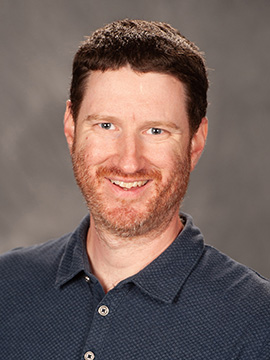Joel Krehbiel

Director of Engineering Education
Email joel.krehbiel@hesston.edu
Phone 620-327-8310
Office Friesen Center
Affiliated Departments or Programs
Education
- B.A., Bethel College (North Newton, Kan.)
- M.S., University of Illinois (Champaign)
- Ph.D., University of Illinois
- Applied mathematics
- Fluid mechanics
- Bioenergy
- Krehbiel, J.D. Motion of a Rocking Rainbow. The Physics Teacher. 62: 174-177, 2024.
- Kilmer, N. and J.D. Krehbiel. Improved Gay-Lussac experiment considering added volumes. The Physics Teacher. 57: 21-25, 2019.
- Krehbiel, J.D., K.N. Schroeder, H. Suzuki, and N. Kilmer. Using a modified Boyles law experiment to estimate the density of salts. The Physics Teacher. 57: 58-59, 2019.
- Krehbiel, J.D. and J.B. Freund. Stokes flow inside a sphere in an inviscid extensional flow. Zeitschrift f ̈ur Angewandte Mathematik und Physik. 68:81, 2017.
- Zhou, Y., L.C. Schideman, D.S. Park, A. Stirbet, Govindjee, S.I. Rupassara, J.D. Krehbiel, M.J. Seufferheld. Characterization of a Chlamydomonas reinhardtii mutant strain with improved biomass production under low light and mixotrophic conditions. Algal Research. 11: 134-147, 2015.
- Krehbiel, J.D., L.C. Schideman, D.A. King, and J.B. Freund. Algal cell disruption using microbubbles to localize ultrasonic energy. Bioresource Technology. 173: 448-451, 2014.
- Krehbiel, J.D., J. Lambros, J.A. Viator, and N.R. Sottos. Digital image correlation for improved detection of basal cell carcinoma. Experimental Mechanics. 50(6): 813-824, 2010.
Personal Statement
The job of the instructor is not to teach; it is to foster an environment where the students want to learn.
Professional Affiliations
- American Physical Society, 2015 to 2020
- American Society for Engineering Education, 2018 to present
- American Association of Physics Teachers, 2019 to present
Courses Taught
- PhSc 200 - Principles of Physical Science
- Phys 203 - College Physics I
- Phys 204 - College Physics II
- Phys 213 - Physics for Scientists and Engineers I
- Phys 214 - Physics for Scientists and Engineers II
- Engr 221 - Statics
- Engr 222 – Dynamics
- Engr 323 – Solid Mechanics
- Engr 360 – Engineering Ethics
- Engr 425 – Introduction to Thermal Sciences
- MaSc 105 - College Algebra
In Addition …
How did you choose to study engineering?
As a child I loved putting things together and taking them apart; I designed new toys from my blocks and Legos. I also enjoyed the logical mathematical language and excelled in math and science classes. When it came time to pick a major in college, I leaned towards math and physics because of good professors and the interesting problems we solved. I also like engineering, which allows me to apply my understanding of math and science to real-world problems. Since math and physics are both about solving problems, my undergraduate degree prepared me well to study engineering in graduate school.What about teaching energizes you?
I get excited about cool math and physics problems. But I know that not everyone does. My goal is for students to see what is so exciting about these types of problems. Teaching is also continual learning, and I love learning new information. I get energized when students ask deeper questions about math, physics or engineering, even if I don’t have the answer. This means I get to learn something new!How has your background and educational experience shaped you as a teacher?
I strive to be as open as my undergraduate professors were. At the liberal arts school where I received my bachelor’s degree, my professors always had their doors open. I seek to be as welcoming and engaging with my students as these professors were. In graduate school, I attended a large university with some wonderful professors as well. These teachers held me to a high standard, and my understanding of engineering grew deeply during these classes. I seek to create an environment with high standards where students can grow.
